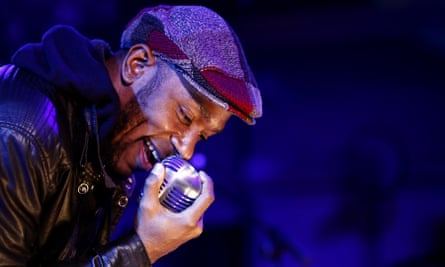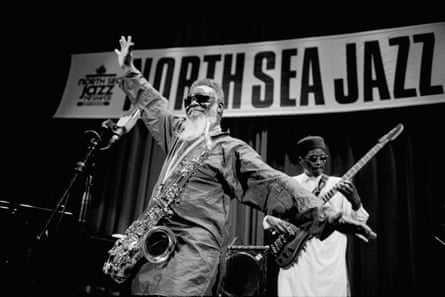The saxophonist was among an assembly of American jazz musicians who reached across continents to find meaning in sound.
The day the music died was 24 September 2022. On that Saturday, the legendary tenor saxophonist Pharoah Sanders, a man who blew his horn “as if he was a dragon breathing fire”,passed on, at age 81. With his death came the end of a majestic era, a time of saxophone spirituality and musical mysticism that will probably never be surpassed or even replicated. Sanders, like so many of his generation, channeled spirit into song, drawing inspiration from a panoply of sacred sources.
For a while, younger hip-hop generations also found words and meaning in a similar kind of search, and the music –along with the quest – continued.
But jazz has changed and hip-hop has changed.
The assembly of American jazz musicians from the mid-20th century who spent their careers seeking spiritual transcendence reads like a pantheon of American genius: John Coltrane, Randy Weston, Yusef Lateef, Ahmad Jamal, Alice Coltrane, Sahib Shahab, Abbey Lincoln, Art Blakey, Sun Ra. These were players willing to take giant steps across scales and continents to find meaning in the sounds of others. They turned that sound into meaning for themselves, and they did it for decades. Central to this sometimes screeching, frequently psychedelic, and always expansive quest was the sonic travel this music took, an inspirational voyage into the mighty souls of African and Asian folks, regularly and intricately braided with, among other influences, the soundscape of Islam.

Never mind that only some of these artists adopted the faith itself. It was their notes and their tones that counted. Plaintive, modal, quarter-toned and chromatic, these aural landscapes of east and west and everything in between stretched the imaginations of both players and audiences. Inside the music, new alliances were forged between people and with all that was holy.
To some people, though, the music just seemed cacophonous and angry. White critics often didn’t understand. Even as astute a thinker as the English Marxist historian Eric Hobsbawm wrote, in 1959, that jazz’s “flight into Mohammedanism or some other non-white culture” was a way to “sidestep” a rising avant-garde jazz that was seeking white acceptance. Describing the era, Hobsbawm explained that “the marvelous political awakening of all the oppressed and underprivileged in Roosevelt’s America put a new tone into the jazz musician’s instrument: open resentment”.
The association between Black rage and a saxophone blasting free has always been too simple to make. By 1969, the Black arts movement poet Sonia Sanchez was mocking white anxieties over Black anger through poetry inspired by Pharoah Sanders. In ways that prefigure some of Dave Chapelle’s most cutting humor, she writes in a poem titled on seeing pharoah sanders blowing: “i’m coming / for u / now with / my / blood / filled / sax. / calling / all / bloods. / beep. / beep. / mary / had / a / little / lamb. / until / she / got / her / throat / cut / see what I mean?” Some might find her words threatening. I think she’s being hilarious.

And it was a love supreme. I’ve argued elsewhere that Coltrane’s most famous song, A Love Supreme, has its own Islamic echoes (the chant “a love supreme” starts to sound a bit like “Allah supreme” after a while). Pharoah Sanders, who played with ’Trane starting in 1965, extended Coltrane’s legacy after his death in 1967.

Meanwhile, Sanders continued to build his own spiritually inflected, religious ecumenical style. His 1969 hypnotic track Hum-Allah-Hum-Allah-Hum-Allah meditates on the words “Prince of peace / Won’t you hear our pleas / And ring your bells of peace / Let loving never cease” for an enveloping and achingly beautiful 15 minutes. His classic The Creator Has a Master Plan had its own second coming when it was re-released in a trip-hop remix in the mid-90s. The Trance of Seven Colors, Pharoah’s work with the master Gnawa musician of Morocco Mahmoud Guinia is simply transcendent on an interstellar plane.
Islam offered these musicians an opportunity to reject the routine and brutal racism of America while also enabling them to explore themselves as full human beings and spiritual seekers. The drummer Art Blakey, who, according to Ebony magazine in 1963, “started looking for a new philosophy after having been beaten almost to death in a police station in Albany, Georgia, because he had not addressed a white policeman as ‘sir’”, explained his attraction to Islam in an interview with a French jazz magazine this way: “Islam brought the Black man what he was looking for, an escape like some found in drugs or drinking: a way of living and thinking he could choose in complete freedom. This is the reason we adopted this new religion in such numbers. It was, for us, above all, a way of rebelling.”

One concert flyer from 1963 shows an event featuring Weston, the percussionist Majid Shabazz, the pianist Sadik Hakim, and “many others projecting new innovations in music”, at Club Sea Breeze in Harlem. The night was themed “African Bag”. Admission was $1.50, and the poster promised “free Egyptian perfume for the ladies”.

Weston also joined forces with master Gnawa musicians in Morocco. (He was playing with them and learning from them before Sanders did the same.) Others, such as Alice Coltrane, were moving in more eastern directions while still others, like Sun Ra, lived in intergalactic space and called us all to move in with him.
The spiritual jazz movement continued, but it didn’t take long for it to be eclipsed by other trends, everything from commercially accessible fusion, launched by the likes of Miles Davis, to the less accessible avant-garde innovations of Cecil Taylor or Albert Ayler. By the 1990s, jazz was also firmly ensconced in the ivory tower, featuring at prestigious arts institutions such as Lincoln Center and the Kennedy Center.
Still, the Islamic influence in American popular music never went away, though it did change addresses. Shifting from sound to word, Muslim references could now be found more in the new hip-hop than in the new jazz, even if hip-hop Islam was a yet more heterodox creed than the one found within the Ahmadiyya community. Foundational hip-hop artists including Rakim, Big Daddy Kane, and the Wu-Tang Clan were invoking the words and numbers of the Nation of Gods and Earths, an offshoot of the Nation of Islam.
The Five Percenters, as they are also known, have their own distinct system of belief along with their own esoteric language. The name Five Percenter comes from the belief that 85% percent of the population are deluded, exploited, and worship a “Mystery God”. Ten per cent are the “rich slave-makers of the poor”, who taught the 85% about their beliefs. The Five Percenters are the “poor righteous teachers” (also the name of an influential early 90s hip-hop band) who struggle for freedom, justice, and equality against the 10%.

Five Percenter language has permeated the pop cultural lexicon. For example, the “G” in “wassup, G?”is not “gangsta”, as many might think, but “God”. In this creed, Five Percenter men are considered Gods, and Five Percenter women are known as Earths. “Dropping science” is a term from the Five Percenters, as is the emphatic term “word”, a short form of “word is my bond”.
Scholars have written on the important influence of Five Percenters on early hip-hop. But there are also other, more mainline Muslim influences on the American scene. Five Percenter doctrine was foundational in hip-hop, but it operated as an esoteric language among the educated and enlightened. The way the language and numerology (with an emphasis on the number 7) operated was to signify kinship and belonging, which was particularly important in the early hip-hop years. But other Muslim rappers, often associated with Sunni Islam, performed their deen, their faith, more in line with the jazz tradition that preceded it, as a search for self.
“Bismillah ir Rahman ir Raheem,” begins Mos Def’s 1999 classic Fear Not of Man, proclaiming the Qur’anic Arabic opening: “In the name of God, the Compassionate, the Merciful.” In the same track, Mos Def (Yasiin Bey) raps: “Hip-hop won’t get better until the people get better / Then how do people get better?” which echoes the commonly known Qur’anic verse: “Indeed, Allah will not change the condition of a people until they change what is in themselves.” Mos Def’s own reply is also a spiritual response to his self-posed question: “Well, from my understanding people get better / When they start to understand that they are valuable / And they not valuable because they got a whole lot of money / Or ’cause somebody think they sexy / But they valuable ’cause they been created by God / And God makes you valuable.”

Mos Def is hardly the only one who invokes this devotional search. A Tribe Called Quest’s Q-Tip (Kamaal Fareed) is another. “Praise the Lord of the worlds that’s unseen / Respect me for that and let me do my thing,” we hear in the song Get a Hold. More recently, the Five Percenters, the Nation of Islam, and Sunni Islam (and more) tentatively unite to find a home in the lyrical power of Jay Electronica. “All I have in this world is my flag and my sword / I’m on the battlefield with the flag of my Lord,” rhymes Electronica in Fruit of the Spirit. “My shahada is my cantada / My heart chakra light up when I make sajda at fajr.”
While spiritual quests such as Jay Electronica’s aren’t as common in today’s hip-hop, the search hasn’t disappeared entirely. After all, the history of Black music shows us time and again how the journey seeking the divine produces such a profound musical experience.
And that’s what Pharoah Sanders leaves behind. His was an unyielding search for a way to transcend the secular ugliness of this world, and with his passing Sanders may have finally achieved that goal. Yet music – like all that is holy – never dies. And Pharoah’s saxophone will honk and shriek and envelop all our senses, reverberating to heaven and back, and maybe even beyond.







More Stories
CD review: George Benson – Dreams Do Come True: When George Benson Meets Robert Farnon – 2024: Video, CD cover
The band was tight as ever. The Warren Haynes Band cuts loose: Video, Photos
Interview with Alvin Queen: Feeling Good – I heard these tunes played by … Video, new CD cover, Photos